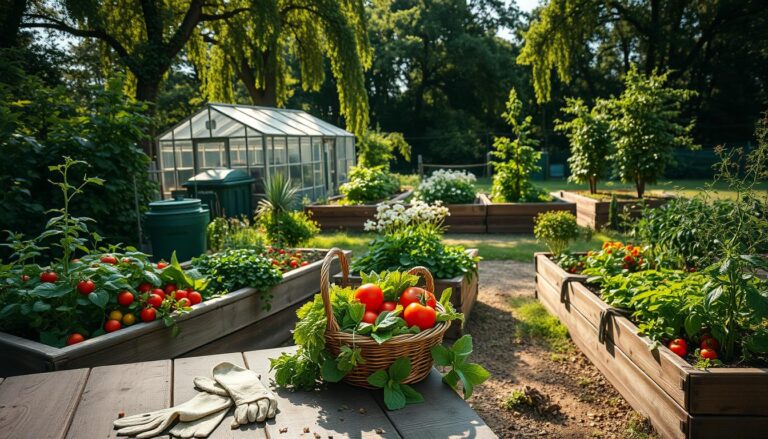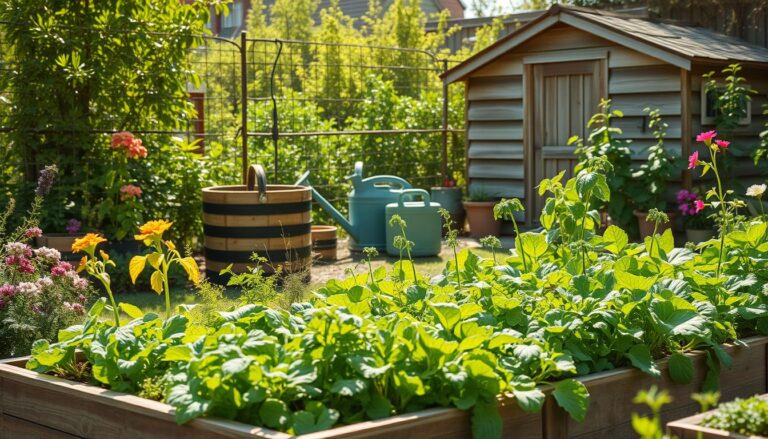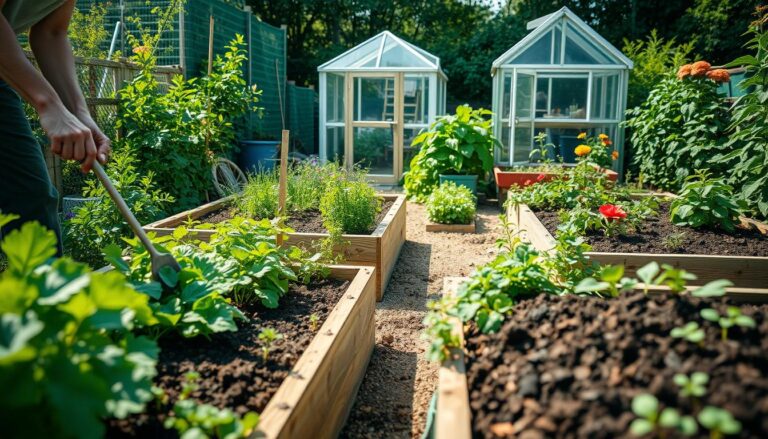Composting is key for keeping soil healthy and fertile. It’s a must in organic gardening practices. Gardeners turn organic waste into a soil amendment full of nutrients, helping plants grow well.
This method cuts down on waste and boosts sustainable gardening. It makes soil better, improves water flow, and helps good microbes. So, composting is vital for gardeners wanting green, healthy gardens.
By composting, gardeners can greatly improve their garden’s output. They also reduce harm to the environment.
Understanding Organic Gardening
Organic gardening is all about creating a balanced garden ecosystem. It avoids using synthetic fertilizers and pesticides. This method ensures healthier plants and helps the environment.
What Is Organic Gardening?
Organic gardening grows plants using natural methods. It doesn’t use synthetic fertilizers, pesticides, or GMOs. Instead, it uses composting, crop rotation, and natural pest control.
This gardening style sees the garden as a whole ecosystem. It aims to make a place where plants, animals, and tiny organisms can live well together.
Key Principles of Organic Gardening
The main ideas of organic gardening are keeping soil healthy, promoting biodiversity, and using natural pest control.
Soil health is key. Using composting and mulching helps the soil. This makes it rich and fertile, reducing the need for synthetic fertilizers.
Another important idea is biodiversity. Growing many different plants helps keep the garden balanced. It also lowers the chance of pests and diseases.
| Practice | Organic Gardening | Conventional Gardening |
|---|---|---|
| Fertilizers | Compost, manure | Synthetic fertilizers |
| Pest Control | Biological, physical barriers | Chemical pesticides |
| Soil Management | Crop rotation, mulching | Intensive tillage, synthetic conditioners |
“Organic gardening is not just about avoiding chemicals; it’s about creating a vibrant ecosystem that supports life.”
What Is Composting?
Composting is the process of turning organic materials into a nutrient-rich soil amendment. It involves breaking down kitchen scraps and yard waste into a valuable resource for gardening.
Definition of Composting
Composting is the controlled breakdown of organic materials into a humus-rich product. This product improves soil structure and fertility. It’s an aerobic process, needing oxygen to work well. Composting techniques for beginners focus on balancing ‘green’ and ‘brown’ materials.
The Composting Process
The composting process starts with collecting organic materials. These include kitchen scraps, yard trimmings, and biodegradable waste. The materials are layered in a compost bin or pile, mixing ‘green’ and ‘brown’ materials. How to compost at home effectively means keeping the right moisture, turning the pile, and checking its temperature.
Microorganisms play a key role in composting. They break down organic matter into compost. Creating a good environment for these microbes helps in successful home composting.
| Composting Materials | Examples | Benefits |
|---|---|---|
| Green Materials | Kitchen scraps, grass clippings | High in nitrogen, speeds up decomposition |
| Brown Materials | Dried leaves, straw | High in carbon, balances green materials |
| Other Materials | Eggshells, coffee grounds | Adds calcium, improves soil structure |
Mastering composting basics helps gardeners create a nutrient-rich soil amendment. This amendment boosts plant growth and reduces waste. Whether starting with how to compost at home or improving composting techniques for beginners, knowing the composting process is essential for gardening success.
Benefits of Composting for Soil Health
Composting offers many benefits for soil health. It improves the soil’s structure and makes nutrients more available. This makes the soil better for plants to grow in. It also helps make gardening more sustainable.
Enhancing Soil Structure
Composting makes the soil better by holding more water and air. Improved soil structure helps roots grow deeper. This is great for soils that are too sandy or too clay-heavy.
- Enhances water retention in sandy soils
- Improves drainage in clay soils
- Supports root growth through better aeration
Improving Nutrient Availability
Compost is full of nutrients plants need to grow. As it breaks down, it slowly releases these nutrients. This slow-release mechanism gives plants what they need over time. It helps them grow strong and healthy.
“Composting is a cornerstone of sustainable gardening, turning waste into a valuable resource that enhances soil fertility and structure.”
With better nutrient availability, composting helps plants grow well. This can lead to bigger harvests and a more lively garden.
The Role of Microorganisms in Composting
Microorganisms are key players in composting. They include bacteria and fungi. These tiny beings break down organic materials into a nutrient-rich compost.
Beneficial Microbes in Compost
Beneficial microbes in compost turn organic materials into a stable, nutrient-rich substance. Bacteria and fungi are the main players. They use enzymes to break down complex molecules into simpler nutrients for plants.
A mix of different microorganisms is crucial for a healthy compost. This variety ensures the compost is full of microbes that help plants grow and fight diseases.
How Microorganisms Aid Decomposition
Microorganisms help break down organic materials into simpler forms. They release enzymes that break down tough molecules like cellulose and lignin. This makes nutrients easier for plants to absorb.
- Microorganisms release enzymes that break down complex organic molecules.
- The decomposition process is faster with beneficial microbes.
- A diverse array of microorganisms ensures a healthy compost ecosystem.
Understanding microorganisms’ role in composting helps gardeners create a thriving compost ecosystem. This supports healthy plant growth and reduces waste. It also improves soil structure and makes nutrients more available for plants.
Composting and Plant Growth
Adding compost to your garden can really help plants grow better. It’s a simple way to give plants the nutrients they need to thrive.
Boosting Plant Nutrition
Compost is full of nutrients like nitrogen, phosphorus, and potassium. These nutrients are slowly released as the compost breaks down. This gives plants a steady supply of what they need.
Nutrient-rich compost makes the soil better, reducing the need for harmful fertilizers. This is good for plants and the environment too.
| Nutrient | Role in Plant Growth |
|---|---|
| Nitrogen | Promotes leaf growth and development |
| Phosphorus | Essential for root development and flower/fruit production |
| Potassium | Helps with overall plant health and resistance to disease |
Encouraging Strong Root Development
Compost is also key for strong root growth. It makes the soil better, letting roots grow deeper and wider. This makes plants more able to handle drought and stress.
Healthy root systems are the base of healthy plants. Compost helps create a great environment for strong root growth. This leads to more vigorous and productive plants.
Reducing Waste Through Composting
Composting is good for the planet and makes our gardens better. It turns kitchen scraps and yard waste into a valuable soil amendment. This way, we send less waste to landfills.
Composting is easy. It breaks down organic stuff into a soil that’s full of nutrients. This not only cuts down on landfill waste but also gives us something great for our gardens.
Kitchen Scraps and Yard Waste
Kitchen scraps like fruit peels, tea bags, and coffee grounds are perfect for composting. Yard waste, like leaves and grass clippings, works too. Mixing these creates a compost pile full of nutrients.
Effective composting needs a mix of “green” and “brown” materials. Green stuff is like kitchen scraps, and brown is dried leaves. This mix is key for composting to work right.
Benefits of Reducing Landfill Waste
Composting cuts down on methane, a bad greenhouse gas. It also saves landfill space and cuts down on the need for chemical fertilizers. This is good for the environment.
By composting, we help the planet. It makes our gardens healthier and fights climate change by lowering greenhouse gas emissions.
To start composting at home, just set up a bin and mix your materials right. Turn the compost pile often. It’s a simple way to make a big difference for our planet.
Types of Composting Methods
Composting techniques vary, offering gardeners a range of options. Whether you’re a seasoned gardener or just starting, knowing the different methods is key. It helps you choose the best approach for your organic gardening journey.
Traditional Composting
Traditional composting is a common method used by gardeners. It involves creating a compost pile or using a compost bin. This method is simple and can fit different spaces and needs.
To ensure effective traditional composting, it’s essential to maintain the right balance of green and brown materials. Keep the pile moist and turn it regularly.
Key benefits of traditional composting include:
- Flexibility in terms of size and location
- Ability to compost a wide range of organic materials
- Cost-effective, as it often utilizes readily available materials
Vermicomposting
Vermicomposting, also known as worm composting, uses worms to break down organic matter. It’s great for indoor composting and can be fun for kids. Vermicomposting produces a high-quality compost that is rich in nutrients and beneficial microbes.
Some advantages of vermicomposting include:
- Space efficiency, making it ideal for urban gardeners
- Fast decomposition process
- Production of a nutrient-rich compost
Bokashi Composting
Bokashi composting is a fermentation-based method from Japan. It involves layering organic materials in a specific way and using microorganisms to break down the waste. Bokashi composting can compost a wide range of materials, including meat and dairy, which are typically avoided in traditional composting.
Benefits of bokashi composting include:
- The ability to compost a broader range of organic materials
- Faster composting process compared to traditional methods
- Reduced odors and pests
By understanding the different types of composting methods, gardeners can make informed decisions. Whether you choose traditional composting, vermicomposting, or bokashi composting, success depends on maintaining the right conditions and being consistent.
What to Include in Your Compost
Successful composting is all about mixing green and brown materials. Green stuff, like kitchen scraps, is full of nitrogen. Brown stuff, like dried leaves, is full of carbon. Together, they make compost that’s good for your soil.
Green Materials vs. Brown Materials
It’s important to know the difference between green and brown materials. Green materials are high in nitrogen, like kitchen scraps and grass clippings. Brown materials are high in carbon, like dried leaves and straw.
Keep your compost pile at a 2/3 brown to 1/3 green ratio. This mix keeps the composting process efficient and smell-free.
Common Items to Compost
Knowing what to compost can make your compost better. Here are some green and brown materials you can use:
| Material Type | Examples | Nutrient Value |
|---|---|---|
| Green Materials | Kitchen scraps, grass clippings, manure | High in Nitrogen |
| Brown Materials | Dried leaves, straw, shredded newspaper | High in Carbon |
But, don’t compost everything. Stay away from meat, dairy, and oily foods. They can attract pests and smell bad.
By mixing green and brown materials and using a variety of composting items, you can make compost. This compost is rich in nutrients and helps plants grow well.
Troubleshooting Composting Issues
Composting is vital for sustainable gardening, but it can face challenges like odors and pests. Knowing how to solve these problems is key to a healthy compost.
Odor Problems
Odors from compost piles can be a big problem. These smells usually come from an imbalance in the composting process. This imbalance can happen when there are too many green materials and not enough brown ones.
To fix odor issues, it’s important to balance the carbon-to-nitrogen ratio in your compost. Adding more brown materials helps soak up moisture and cuts down on smells. Also, turning the compost pile regularly helps it breathe better. This speeds up decomposition and reduces bad smells.
| Cause of Odor | Solution |
|---|---|
| Too many green materials | Add more brown materials (e.g., dried leaves, straw) |
| Insufficient aeration | Regularly turn the compost pile |
| Excess moisture | Add absorbent materials like straw or shredded newspaper |
Pest Control in Compost
Pests like rodents or flies can be a big problem in compost. They are drawn to the pile because of kitchen scraps or other nutrient-rich materials.
To keep pests away, bury new materials under a layer of existing compost or brown materials. This makes it harder for pests to get to them. Also, don’t add meat, dairy, and oily foods to the compost. These attract pests.
By tackling common composting problems, gardeners can keep their compost healthy and productive. This boosts the benefits of composting and supports sustainable gardening.
Best Practices for Successful Composting
To compost successfully, follow key practices. These ensure your compost thrives. It’s about the right conditions and regular upkeep.
Maintaining the right moisture level is crucial. Your compost pile should be moist, like a damp sponge. Too dry, and decomposition stops. Too wet, and it smells bad.
Maintaining the Right Moisture Level
Microorganisms need moisture to work. Check the compost’s moisture by squeezing it. If it’s dry, add water. If too wet, add dry stuff like straw.
Monitoring moisture levels is key, especially in extreme weather. Adjust the moisture to keep decomposition going well.
Turning Your Compost Pile
Turning your compost pile regularly is vital. It aerates the pile, ensuring even decomposition. It also speeds up the process and prevents bad smells.
How often to turn depends on your composting method and materials. Usually, every few weeks is enough. But adjust based on your pile’s condition.
By following these practices, you can make nutrient-rich compost. It supports plant growth and reduces waste. Composting at home is good for your garden and the environment. It helps reduce food waste with composting.
Timing Your Compost for Gardening
To get the most out of your compost, knowing when to use it is key. Timing affects your garden’s health and productivity. It’s all about when to add compost to your gardening routine.
When to Use Finished Compost
Finished compost is useful at different plant growth stages. For seed starting, a bit of compost in the soil helps seedlings grow well. When transplanting, compost in the planting hole helps plants adjust and grow roots.
For established plants, compost can be used as mulch or mixed into the soil. This boosts nutrients and soil structure. It’s also good to add compost when preparing soil for new plants to improve fertility and drainage.
| Plant Growth Stage | Compost Application Method | Benefits |
|---|---|---|
| Seed Starting | Mix into soil | Nutrient-rich environment |
| Transplanting | Add to planting hole | Reduces shock, promotes root development |
| Established Plants | As mulch or mixed into soil | Boosts nutrients, improves soil structure |
Seasonal Composting Tips
The season affects when to use compost. In spring, mix compost into the soil for new plants. In summer, compost mulch keeps soil moist and weeds away. In fall, compost replenishes soil nutrients and structure for the next season.
Knowing when to apply compost and following seasonal tips can greatly benefit your garden. This leads to healthier plants and more productive gardens. For more organic gardening tips and composting techniques for beginners, check out our resources.
Conclusion: Embracing Composting for a Thriving Garden
Composting is a key to a thriving, sustainable garden. It helps plants grow well, cuts down on waste, and makes gardening better for the planet.
Composting is crucial for organic gardening. It makes soil better, adds nutrients, and helps roots grow strong. This leads to healthier plants.
Adding composting to your gardening routine helps the environment and makes your garden beautiful. It’s a simple way to have a lush, vibrant garden.
Think about composting’s benefits and start using it in your garden today.
FAQ
What is the importance of composting in organic gardening?
How do I start composting at home?
What are the benefits of composting for soil health?
What materials can I compost?
How do microorganisms contribute to the composting process?
How can I troubleshoot common composting issues like odors and pests?
When is the best time to use finished compost in my garden?
What are some best practices for successful composting?
How does composting help reduce waste?
Can I use composting for sustainable gardening practices?

Sortemdia nasceu com o propósito de trazer alegria e oportunidades para todos por meio de sorteios gratuitos de prêmios incríveis. O site tem como missão oferecer experiências acessíveis, divertidas e justas para quem deseja concorrer a produtos, serviços e brindes sem pagar nada por isso. Acreditamos que a sorte pode bater à porta de qualquer pessoa — e no Sortemdia, ela pode chegar com apenas um clique.



